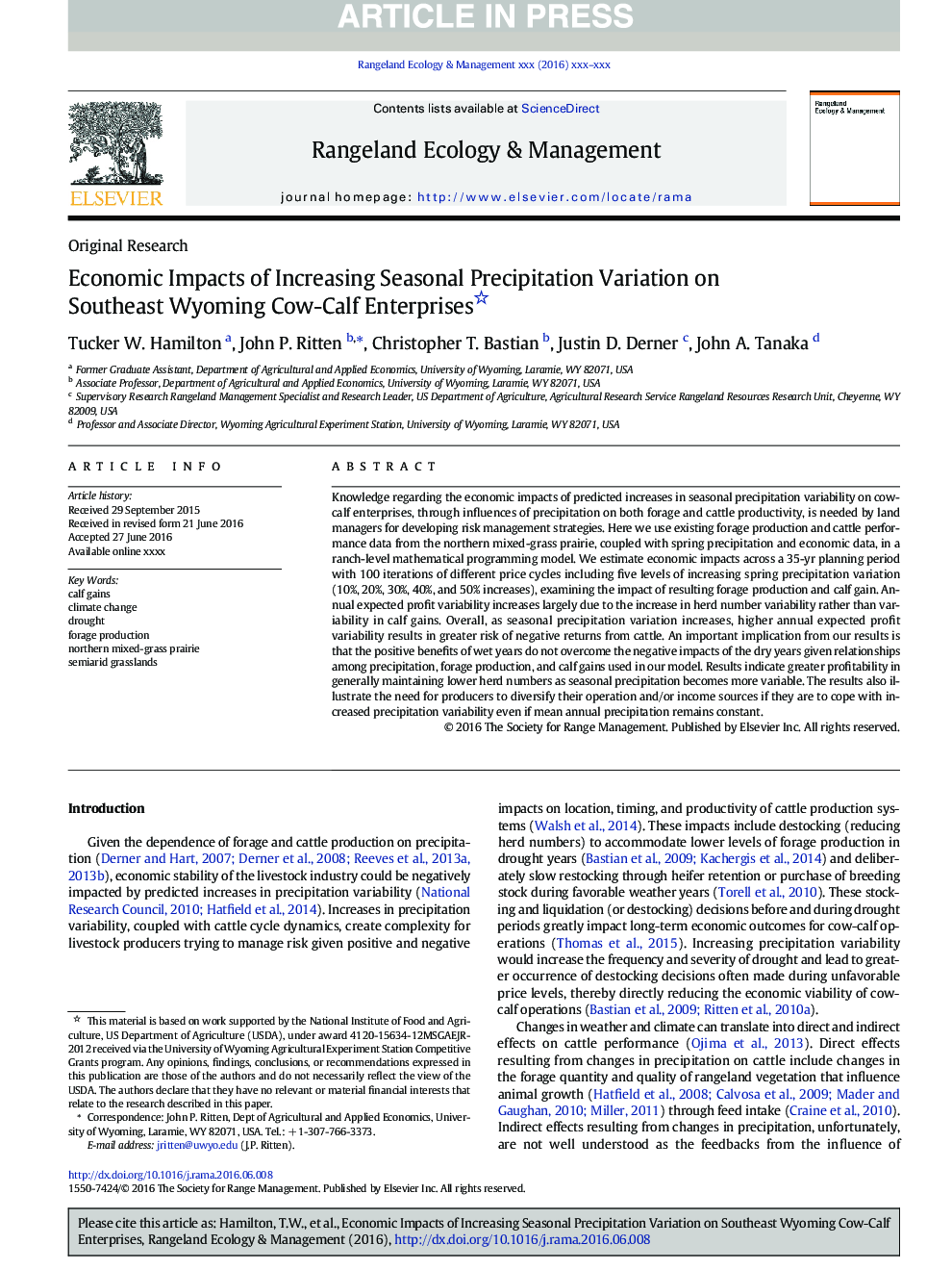| کد مقاله | کد نشریه | سال انتشار | مقاله انگلیسی | نسخه تمام متن |
|---|---|---|---|---|
| 5745261 | 1412391 | 2016 | 9 صفحه PDF | دانلود رایگان |
عنوان انگلیسی مقاله ISI
Economic Impacts of Increasing Seasonal Precipitation Variation on Southeast Wyoming Cow-Calf Enterprises
ترجمه فارسی عنوان
تاثیرات اقتصادی افزایش تغییرات بارش فصلی در شرکت های گاو و گوسفند جنوب شرقی وایومینگ
دانلود مقاله + سفارش ترجمه
دانلود مقاله ISI انگلیسی
رایگان برای ایرانیان
کلمات کلیدی
دستاوردهای گوساله، تغییر آب و هوا، خشکی، تولید علوفه، شمال روستای مخلوط چمن، علفزارهای نیمه آرامی،
ترجمه چکیده
آگاهی از تاثیرات اقتصادی افزایش پیش بینی شده در تغییرات بارندگی فصلی بر شرکت های گاو و گوساله، از طریق تاثیر بارش بر روی تولید علوفه و گاو، توسط مدیران زمین برای ایجاد استراتژی های مدیریت ریسک مورد نیاز است. در اینجا ما از داده های عملکرد علوفه ای و گاوهای موجود در شمال پیشخان چمن مخلوط با بارش بهاره و داده های اقتصادی در مدل برنامه ریزی ریاضی سطح مزرعه استفاده می کنیم. ما تخمین های اقتصادی را در یک دوره برنامه ریزی 35 ساله با 100 تکرار از چرخه های مختلف قیمت شامل پنج سطح افزایش بارندگی بارش بهاری (10٪، 20٪، 30٪، 40٪ و 50٪ افزایش)، بررسی تاثیر نتیجه تولید علوفه و افزایش گوساله. تغییرات سود سالیانه مورد انتظار به طور عمده به دلیل افزایش تعداد متغیرهای گله به جای تغییر در درآمد گوساله افزایش می یابد. به طور کلی، به دلیل تغییرات بارش فصلی، افزایش متغیر سود سالانه مورد انتظار افزایش ریسک بازده منفی از گاو را افزایش می دهد. یک نتیجه مهم از نتایج ما این است که مزایای مثبت سال های مرطوب بر تاثیرات منفی سال های خالی بر روابط بین بارش، تولید علوفه و سود بالایی که در مدل ما استفاده می شود غلبه می کنند. نتایج نشان می دهد که سودآوری بیشتر در حفظ تعداد کمتری از گله ها به عنوان بارش فصلی متغیر است. نتایج همچنین نشان می دهد که نیاز به تولیدکنندگان برای گوناگونی عملیات و / یا منابع درآمد خود، اگر آنها برای مقابله با افزایش بارندگی متغیر، حتی اگر میانگین بارش سالانه ثابت باقی می ماند.
موضوعات مرتبط
علوم زیستی و بیوفناوری
علوم کشاورزی و بیولوژیک
علوم کشاورزی و بیولوژیک (عمومی)
چکیده انگلیسی
Knowledge regarding the economic impacts of predicted increases in seasonal precipitation variability on cow-calf enterprises, through influences of precipitation on both forage and cattle productivity, is needed by land managers for developing risk management strategies. Here we use existing forage production and cattle performance data from the northern mixed-grass prairie, coupled with spring precipitation and economic data, in a ranch-level mathematical programming model. We estimate economic impacts across a 35-yr planning period with 100 iterations of different price cycles including five levels of increasing spring precipitation variation (10%, 20%, 30%, 40%, and 50% increases), examining the impact of resulting forage production and calf gain. Annual expected profit variability increases largely due to the increase in herd number variability rather than variability in calf gains. Overall, as seasonal precipitation variation increases, higher annual expected profit variability results in greater risk of negative returns from cattle. An important implication from our results is that the positive benefits of wet years do not overcome the negative impacts of the dry years given relationships among precipitation, forage production, and calf gains used in our model. Results indicate greater profitability in generally maintaining lower herd numbers as seasonal precipitation becomes more variable. The results also illustrate the need for producers to diversify their operation and/or income sources if they are to cope with increased precipitation variability even if mean annual precipitation remains constant.
ناشر
Database: Elsevier - ScienceDirect (ساینس دایرکت)
Journal: Rangeland Ecology & Management - Volume 69, Issue 6, November 2016, Pages 465-473
Journal: Rangeland Ecology & Management - Volume 69, Issue 6, November 2016, Pages 465-473
نویسندگان
Tucker W. Hamilton, John P. Ritten, Christopher T. Bastian, Justin D. Derner, John A. Tanaka,
